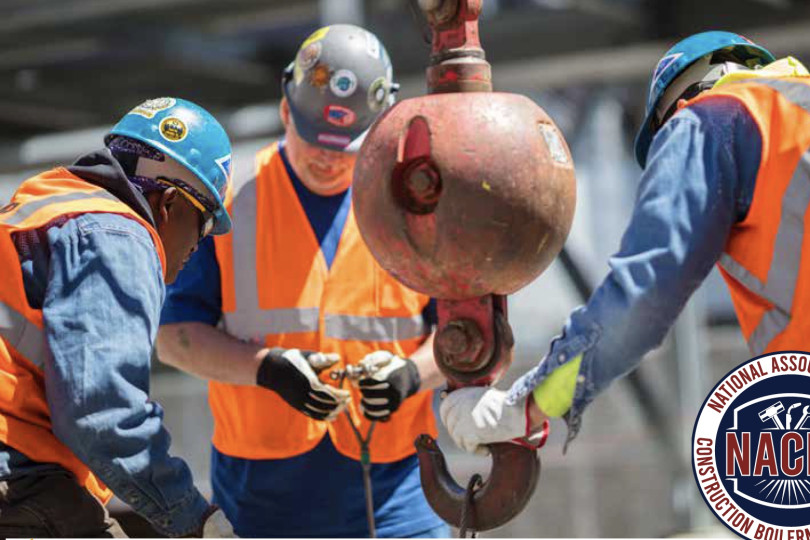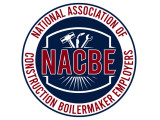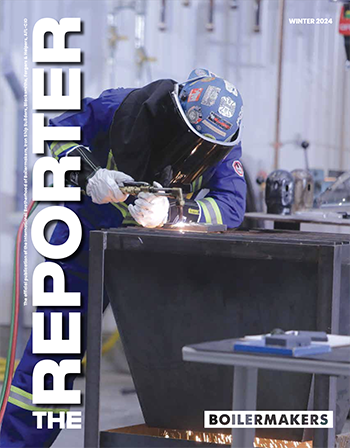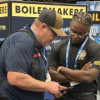“Everyone wins through our partnership with NACBE. We’re just better together.”
Open communication and working well together are the keys to any successful relationship. And when it comes to winning more work opportunities and putting prepared Boilermakers on the job safely, those are imperative components in the relationship between union Boilermakers and the contractors who employ them.
That’s the premise that built NACBE—the National Association of Construction Boilermaker Employers—back in 1975 and what keeps the partnership between NACBE and the Boilermakers union relevant and vital today, nearly 50 years later.
“If we can’t work together, we can’t get anything accomplished,” says NACBE Executive Director Ron Traxler. “We’re nothing if we don’t work together.”
Traxler explains that in the mid 1970s, as the anti-union movement tried to gain footing, no forum existed for Boilermakers and contractors to bring forth issues, discuss them and work together to solve them. Charles “C.W.” Jones, who was then IVP of the Southeast Section and had worked to establish the Construction Division, recognized the need and had an idea to bring the two entities together to do just that.
“There was infighting back and forth and there was really no communication from local business managers to the Executive Council and contractors or drilled down to members,” Traxler says. “It was time for us to get together and say, ‘Look: We’ve got these issues; you’ve got these issues. The only way we’re going to fix this problem is to work together and talk about these issues.’”
So NACBE was created—and just in time, as the anti-union movement began surging in the 1980’s, making joint problem-solving critical. There are currently about 80 NACBE contractor members, and over the decades, the NACBE partnership has increased safety, created efficiency and solved quite a few headaches along the way.
Alan Howkin, who is retired from PMC, joined the NACBE board of directors in 1995 and was one of the longest serving board members, retiring from that role two years ago.
“What I’ve always enjoyed,” he says, “is the ability to sit and meet with people who from time to time are almost opposed to your way of thinking. When NACBE was formed it brought us all into the same family.”
As much as it is a discussion-based group, NACBE is data driven. Members are encouraged to share specific injury report data points, which allows the group to home in on priority problems and measure the success of programs, comparing statistics year over year. The more members share their data, the better the analysis to inform decisions. Members also get exclusive access to data they can use to highlight Boilermaker workforce safety as a means of winning work with employers.
Safety is a top-priority issue for NACBE, which is why the organization’s Safety Committee is a top-priority program. Each contractor member sends a representative to Safety Committee meetings, which take place three times a year. The Safety Committee brings in relevant speakers, representatives from organizations such as the Occupational Safety and Health Administration and the National Institute for Occupational Safety and Health, and safety-gear vendors. The group has roundtable discussions to talk about what’s happening on jobsites, share concerns, identify ways to make positive change and create programs that increase safety.
“They may be competitors as contractors, but when it comes to safety, there are no secrets,” Traxler says. “If you’re doing something on your site that will help another contractor with better safety on their site, there’s no reason not to share it.
“We all have the same issues. Our issues are people issues: How do we work safer and not get hurt.”
Data proves the Safety Committee model works. Recorded injuries and lost-time injury rates have generally decreased, sometimes dramatically, plummeting from 13.54% in 1990 to 1.23% in 1998 and down to .24% in 2022. while there was an uptick in 2023 injury rates, the overall trend remains downward (read Philadelphia Local 13 earns top NACBE safety award) .
Just one of the big safety wins from the committee is the prescription safety eyewear program created in 1992, which remains in practice. Traxler explained that data showed an increase in recordable eye injuries, which made it a priority for NACBE to address.
While standard eye protection is available from contractors and on site, it was up to workers to provide their own prescription eye protection if needed. The program makes prescription eye protection available at no cost twice a year to construction Boilermakers.
“Before, about a third of injuries reported were eye injuries,” says Mark Garrett, Director of Health and Safety. “We can still improve, but we’re doing a lot better now.”
Eye injuries have shrunk 62% since the program’s inception, with 30 compensable eye injuries (according to NACBE members' reported data) and one OSHA eye injury reported in 2022.
The program is funded by MOST and contractors. In fact, MOST, which is the Mobilization, Optimization, Stabilization and Training trust, is itself a product of NACBE’s handiwork. The Boilermakers union and NACBE formed MOST in 1989 in a joint effort to create a funding mechanism to develop and implement the programs and solutions they, along with the National Tripartite Alliance, identified and continue to develop today.
“This is such a good alliance with open conversations about what’s needed,” says Garrett, who is also the MOST Administrator. “Communication is the foundation for everything, and it’s refreshing to have that open communication with contractors.”
New mental health resources are the latest in the works from the Boilermakers, NACBE and MOST (read Boilermakers embrace mental health awareness to support members).
Common Arc is another important NACBE-conceptualized program—one that saves time and money for Boilermakers and contractors.
In 1988, NACBE created Common Arc as a centralized welding test program, which essentially “prescreens” Boilermakers through mass testing events that qualify and certify those whose work passes the scrutiny of contractors representing multiple companies. The concept was based on a testing and certification program established by Local 169 (Detroit) in 1986.
Before Common Arc was created, Boilermakers had to perform a jobsite administered welding test and additional training every time they went to work for a different employer—sometimes taking the same welding test for different contractors in the same week at the same facility. Traxler says it wasn’t uncommon that contractors would wind up with 20-25 who couldn’t pass the test, wasting time and money.
According to Grace Under Pressure, the delays caused by testing and test failures also meant facilities sat idle: “An electric utility, for example, could lose as much as $5 million per hour during periods of peak energy needs.”
“Common Arc creates efficiency financially and with timing. When Boilermakers go into the gate, they can go right to work,” Traxler says. “It’s a big cost savings to have men and women ready to go to work right away on the job site.”
The program has resulted in a 95% annual average cost savings, not to mention reducing frustration for Boilermakers who had to endure redundant testing—or drive hours only to potentially fail a test on site and be turned away from the job.
“NACBE is an integral partner to the Boilermakers union,” says International President Warren Fairley. “Through the data NACBE members provide and the dialog we have together, we’ve solved some important problems that have protected Boilermakers’ safety on the job and helped us provide the ready-to-work manpower our contractors need to be successful with the employers we both serve.
“Everyone wins through our partnership with NACBE. We’re just better together.”
Adds Howkins: “I think NACBE just brings us all closer and makes the table a little smaller to sit around to have a deep discussion—a deep conversation about what we’re facing. When things are clearly put on the table and friendship and respect are built, we achieve amazing things together.”
Check out NACBE’s new website, and learn more about their programs
Learn more about MOST programs, including the prescription eye protection program.







